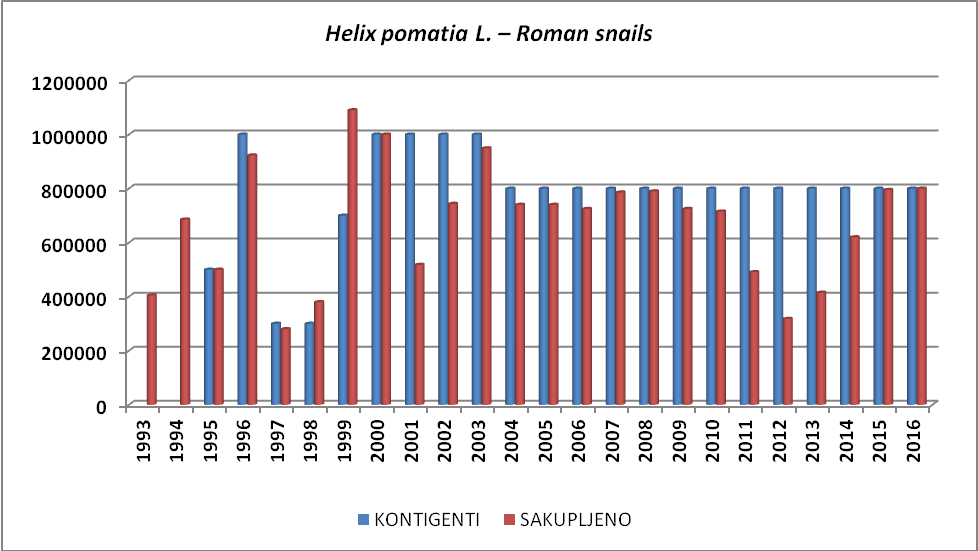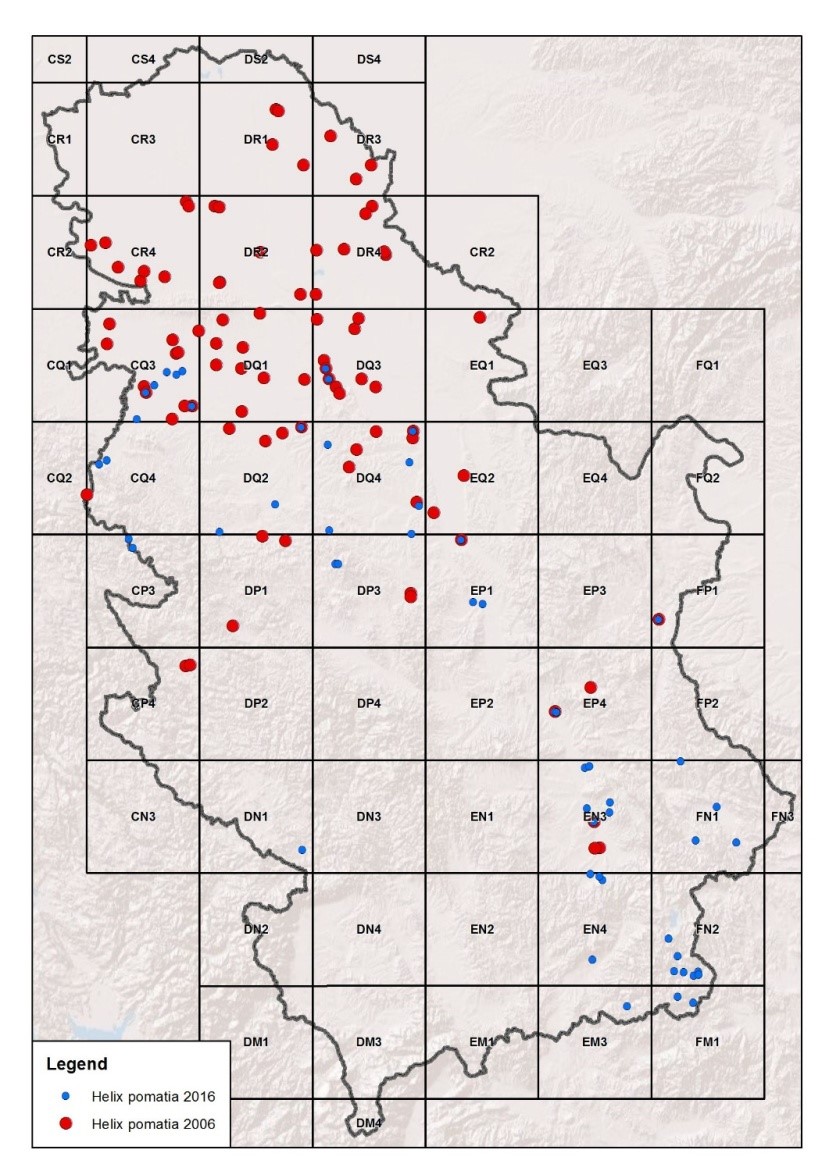The number of species included in the control of wildlife use and trade in the period 1993-2016 amounted to a total of 13. The current Regulation on the control of use and trade covered 9 species of animals. The most endangered species of animals harvested from nature are undoubtedly snails. By analysing the Annual Reports of the Institute for Nature Conservation of Serbia for the period 1993- 2016, for species of animals, it is noted that the most affected by collecting are three types of snails: Helix pomatia-vineyard snail, Helix lucorum-forest snail and Helix aspersa-garden (Mediterranean) snail. The vineyard snail is the most collected. When it comes to harvesting and trade of snails from nature, it was observed that large quantities were collected over the approved period, especially in April and May, when snails are the most active due to reproduction. Large quantities are illegally exported to Bosnia and Herzegovina, North Macedonia, Montenegro and others. According to the Annual Reports of the Institute for Nature Conservation of Serbia, according to the findings of the Institute at the time when the collection is not allowed (April, May), from 5,000 to 7,000 tons are collected. In the mentioned reports, it is stated that this is a common practice from previous years, and that inspection control must be strengthened, especially at well-known purchase points, warehouses-refrigerators, for those enterprises dealing with the trade-processing and export of snails. Frogs are also threatened by collection.

Subindicator Name: Collection of wild fauna – vineyard snail, green frogs
Institution/Author: University Futura/dr Radomir Mandić, Environmental Protection Agency/Slaviša Popović
Use and interpretation:
The Indicator shows level of uses of wild fauna – vineyard snail, green frogs
Key question(s) which indicator helps to answer
What is the level of exploitation of wild fauna in Serbia? Are wild fauna used in sustainable way?
Use of indicator
This indicator is used to monitor exploitation of vineyard snail, green frogs in order to prevent threating by harvesting.
Scale of appropriate use
The number of species included in the control of wildlife use and trade in the period 1993-2016 amounted to a total of 13. The current Decree on the Control of Use and Trade covered 9 species of animals. The most endangered species of animals harvested from nature are undoubtedly snails. By analyzing the Annual Reports of the Institute for Nature Protection of Serbia for the period 1993- 2016, for species of animals, it is noted that the most affected by collecting are three types of snails: Helix pomatia-vineyard snail, Helix lucorum-forest snail and Helix aspersa-garden (Mediterranean) snail. The vineyard snail is the most collected.
Potential for aggregation:
Meaning of upward or downward trends („good or bad“)
When it comes to harvesting and trade of snail from the nature, it was observed that large quantities were collected over the approved period, especially in April and May, when the snails are the most active due to reproduction. Large quantities are illegally exported to Bosnia and Herzegovina, North Macedonia, Montenegro and others. According to the Annual Reports of the Institute for Nature Conservation of Serbia, according to the findings of the Institute at the time when the collection is not allowed (April, May), from 5 000 to 7 000 tons are collected. In the mentioned reports, it is stated that this is a common practice from previous years, and that inspection control must be strengthened, especially at well-known purchase points, warehouses-refrigerators, for those enterprises dealing with the trade-processing and export of snails. Frogs are also threatened by collection.
Possible reasons for upward or downward trends:
Since 1993, in Serbia, the collection and placing on the market of wild species of animals has been legally regulated, by the Order on putting control of the use and trade of wild plant and animal species (Official Gazette of RS, Nos. 50/93 and 36/94). Today, permits for the collection and trade of wild animals are issued on the basis of the Decree on the Control of the Use and Trade of Wild Flora and Fauna (Official Gazette of RS, Nos. 31/05, 45/05, 22/07, 38/08, 9/09 and 69/11), and the licenses are issued by the Ministry of Environmental Protection, based on the opinion of the Institute for Nature Protection of Serbia.
Implications for biodiversity management of change in the indicator:
Units in which it is expressed:
kg per year, number of samples per year
Description of source data:
Ministry of Environmental Protection, Institute for Nature Conservation
Calculation procedure:
Processing the data collected during 24 years, concerning regulations from 1993-2016.
Most effective forms of presentation:
(graph types, maps, narratives,etc.-give examples where possible):
The best ways to present this indicator are graphs and tables.
Limits to userfelness and accuracy:
Access to data for analysis
Updating the indicator:
Annually
Closely related indicators
Export of wild flora and fauna
Additional information and comments
